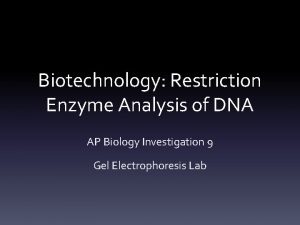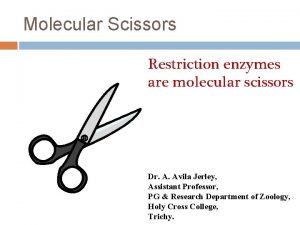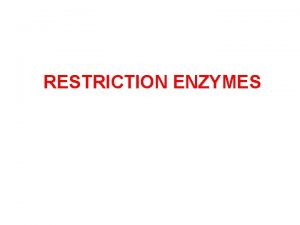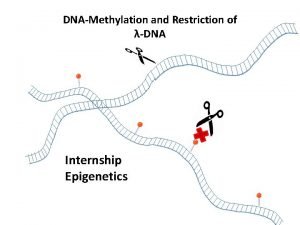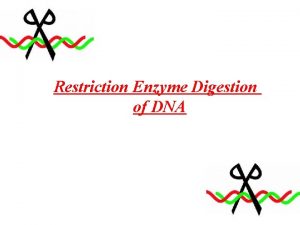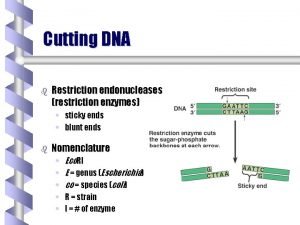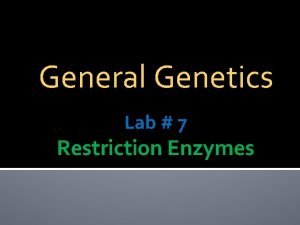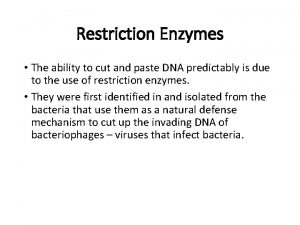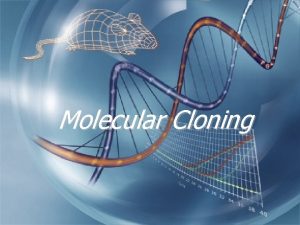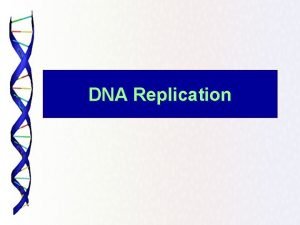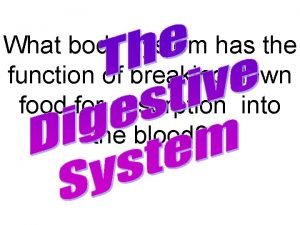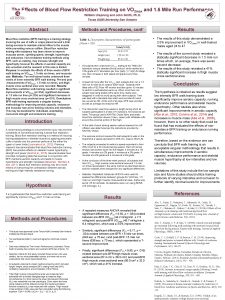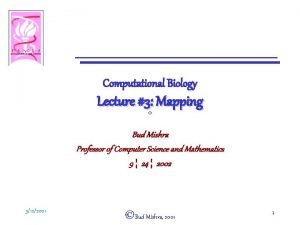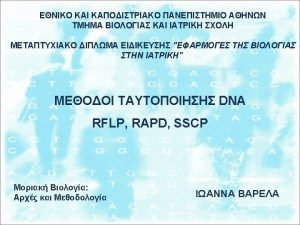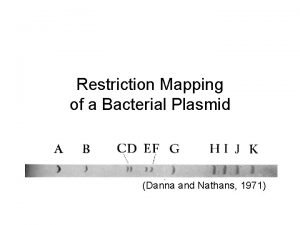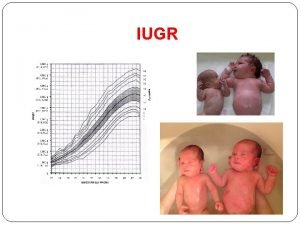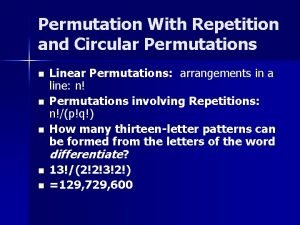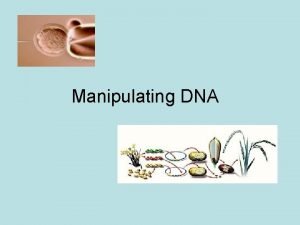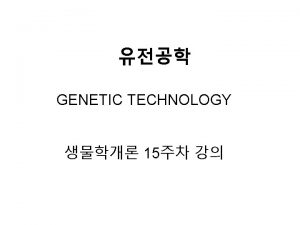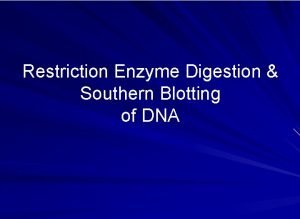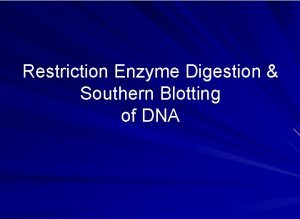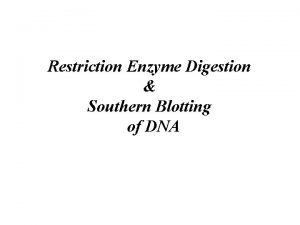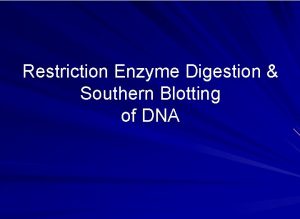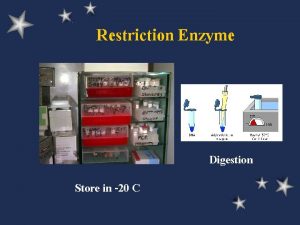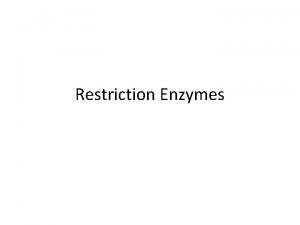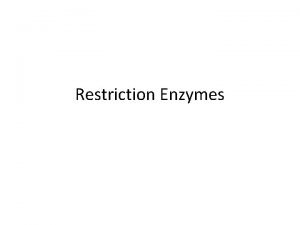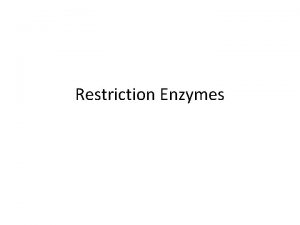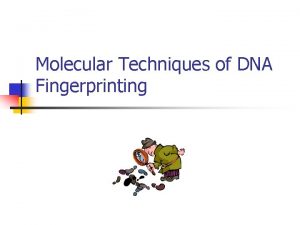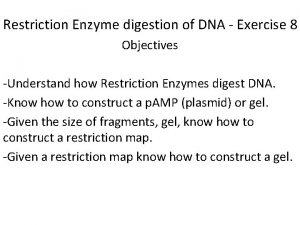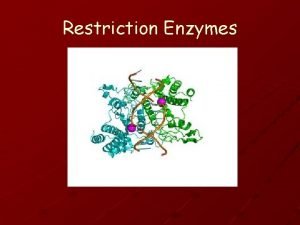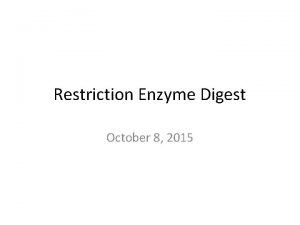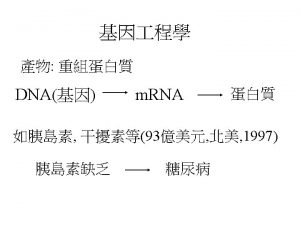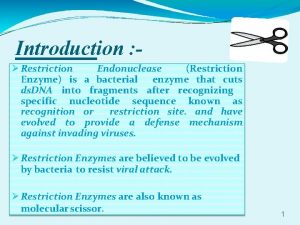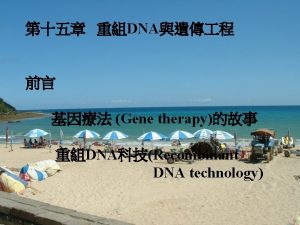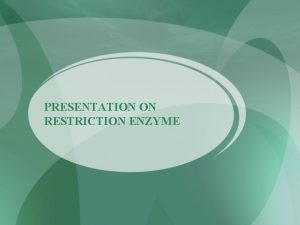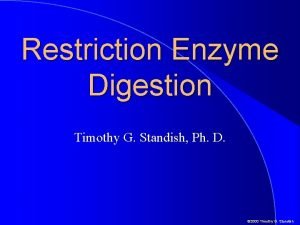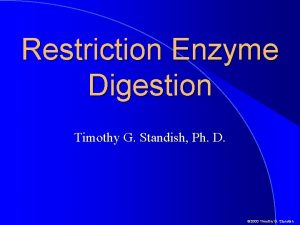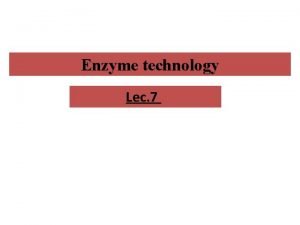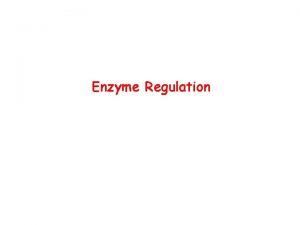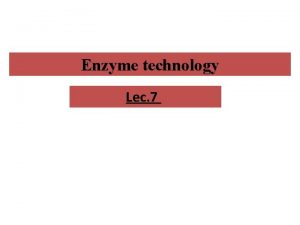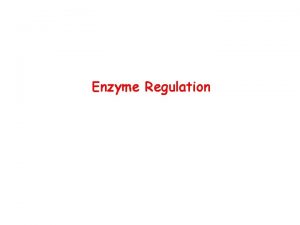Restriction Enzyme Digestion of DNA Experiment Goals Digestion






























- Slides: 30

Restriction Enzyme Digestion of DNA

Experiment Goals • Digestion of DNA by restriction enzyme • Analyze digested DNA by electrophoresis

Restriction Enzymes • Restriction enzymes are endonucleases (Endo (inside), nuclease(cuts nucleic acid), which catalyze the cleavage of the phosphodiester bonds within both strands of DNA. • They require Mg+2 for activity and generate a 5 prime (5') phosphate and a 3 prime (3') hydroxyl group at the point of cleavage.

• The distinguishing feature of restriction enzymes is that they only cut at very specific sequences of bases. This specific DNA sequence is called recognition sequence. Restriction enzymes are traditionally classified according to the subunit composition, cleavage position, sequence-specificity and cofactor requirements.

• A restriction enzyme requires a specific double stranded recognition sequence of nucleotides to cut DNA. • Recognition sites are usually 4 to 8 base pairs in length. • Cleavage occurs within or near the site.

Naming of Restriction enzymes • Restriction enzymes are named according to the organism from which they are isolated. • This is done by using the first letter of the genus followed by the first two letters of the species and additional letter or number represent the strain or serotypes. • Only certain strains or sub-strains of a particular species may produce restriction enzymes.

Example of RE naming: Hind. II: Restriction enzyme was isolated from Haemophilus influenzae serotype d • There are hundreds of different REs from different microorganisms. • Different restriction recognition sequences. enzymes have different • This makes it possible to create a wide variety of different gene fragments.

Examples: Target sequence Enzyme Organism from which derived (cut at *) 5' -->3' Bam HI Bacillus amyloliquefaciens G* G A T C C Eco RI Escherichia coli RY 13 G* A A T T C Hind III Haemophilus inflenzae Rd A* A G C T T Mbo I Moraxella bovis *G A T C Pst I Providencia stuartii CTGCA*G Sma I Serratia marcescens CCC*GGG Taq I Thermophilus aquaticus T*CGA Xma I Xanthamonas malvacearum C*CCGGG



Many recognition sequences are palindromic. For example, 5’ GAATTC 3’ 3’ CTTAAG 5’ palindromic: read the same in the opposite direction

Sticky and Blunt end cutters Not all restriction endonucleases cut symmetrically and leave blunt ends. Many endonucleases cleave the DNA backbones in positions that are not directly opposite each other or can make staggered cuts, which produce single stranded “sticky-ends” DNA from different sources can be spliced easily because of these sticky-end overhangs.

Example of RE that produce sticky end cutters:

Some restriction enzymes cut DNA at opposite base. They leave blunt ended DNA fragments These are called blunt end cutters Hae. III

Restriction Enzyme Uses 1. Recombinant DNA technology *Discovery of enzymes that cut and paste DNA make genetic engineering possible. *Restriction enzyme cuts DNA and generates fragments *Ligase joins different DNA fragments *DNA fragments from different species can be ligated (joined) to create Recombinant DNA


2. Cloning Replicates a sequence inserted into a host cell 3. DNA restriction mapping The location of the restriction enzyme cleavage sites on the DNA molecule.



Biological Function • Restriction enzyme is part of the cell’s restriction -modification system in bacteria. • The phenomenon of restriction modification in bacteria is a small scale immune system for protection from infection by foreign DNA. • Bacteria can protect themselves only after foreign DNA has entered their cytoplasm.

Unit Determination Assay • One unit of restriction endonuclease is defined as the amount of enzyme required to digest one microgram of the appropriate substrate DNA completely in 60 minutes under the conditions specified for that enzyme.

Set up of a restriction enzyme reaction • A RE reaction contains the DNA to be analyzed, • A restriction enzyme buffer mix. – contains a buffering agent to maintain constant p. H, – and Mg++ (from Mg. Cl 2) as a necessary cofactor for enzyme activity.

Digestion by Restriction Enzyme • Measure the DNA concentration – Use the Nano-drop spectrophotometer to measure the concentration of DNA, this is used to determine the amount of Hinf. I restriction enzyme to be used. Digestion of DNA • Mix the following components in a clean microtube. • Mix gently and spin down for a few seconds. • Incubate at 37°C for 16 hours.


Analysis of DNA digestion • Analyze products on 2% agarose gel containing ethidium bromide. • Samples are prepared with loading dye and then loaded on the gel. • Visualize the PCR product on UV transilluminator.

Electrophoresis of Genomic DNA Odd numbered lanes contain undigested genomic DNA Even numbered lanes contain digested genomic DNA Undigested DNA is represented by a sharp band near the wells of the gel, while smearing indicates digested DNA sample.


Exercise

Q 1 Restriction enzyme Alu. I which recognize sequence 5’ AGCT 3' 3' TCGA 5‘ What are the double strand cut in DNA ( begin at G from 5’)

Q 2: Pst. I RE recognize 5’ CTGCA*G 3' 3' G*ACGTC 5’ What are the digestion products?
 Restriction enzyme analysis of dna ap bio lab
Restriction enzyme analysis of dna ap bio lab Molecular scissors
Molecular scissors Types of restriction endonuclease
Types of restriction endonuclease Cla 1 restriction enzyme
Cla 1 restriction enzyme Restriction enzyme
Restriction enzyme Restriction enzyme mapping
Restriction enzyme mapping Restriction enzyme
Restriction enzyme Restriction enzymes
Restriction enzymes Copy and paste
Copy and paste Strategic goals tactical goals operational goals
Strategic goals tactical goals operational goals Strategic goals tactical goals operational goals
Strategic goals tactical goals operational goals What is restriction digestion
What is restriction digestion Illustration of the steps in restriction digestion and pcr
Illustration of the steps in restriction digestion and pcr Enzyme carbohydrate
Enzyme carbohydrate The principle enzyme involved in dna replication is called
The principle enzyme involved in dna replication is called What are the enzymes involved in dna replication
What are the enzymes involved in dna replication Venn diagram of mechanical and chemical weathering
Venn diagram of mechanical and chemical weathering General goals and specific goals
General goals and specific goals Motivation in consumer behaviour
Motivation in consumer behaviour Bioflix activity dna replication dna replication diagram
Bioflix activity dna replication dna replication diagram Coding dna and non coding dna
Coding dna and non coding dna Dna rna protein synthesis homework #2 dna replication
Dna rna protein synthesis homework #2 dna replication Replication
Replication Blood flow restriction protocol
Blood flow restriction protocol Restriction mapping
Restriction mapping Rflp analysis
Rflp analysis Rflp vs rapd
Rflp vs rapd Restriction mapping
Restriction mapping Iugr
Iugr Circular permutation with repetition
Circular permutation with repetition Restriction fragment length polymorphism
Restriction fragment length polymorphism
